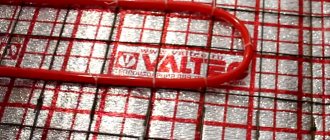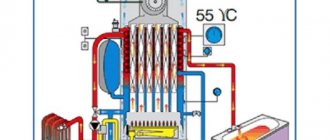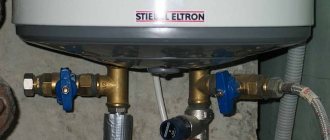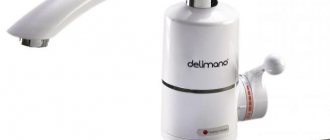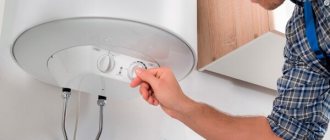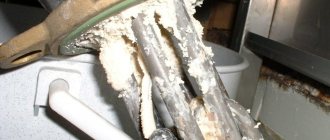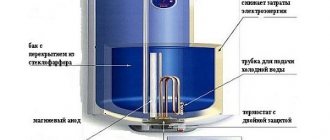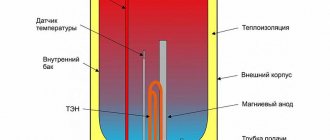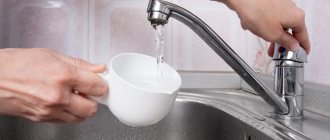Why drain the water?
If you do not drain the water from the boiler on time, the following problems will arise:
- Bacteria and pathogenic microorganisms (E. coli, salmonella, etc.) will appear in the water heater. This point is controversial because microbes do not live in places with high temperatures.
- The tank will become coated with a coating that will be difficult to clean.
- The water will freeze and the boiler will begin to deform. Due to constant pressure, hydraulic components and connections will suffer.
The first point requires detailed consideration. The explanation is simple: when bacteria appear in water, it gives off an unpleasant odor. Similar situations are observed among those who heat water to 45 degrees Celsius and no more. You can do without draining the water: you need to set the maximum heating temperature. Then the foul smell will disappear.
If it was not possible to achieve the desired result, it is better to use another method: heat the tank to an extremely high temperature, repeat this procedure 4-5 times.
Other methods are ineffective; you will have to drain the water.
Some water heaters require drains by default due to the design and design of the heating element (tubular electric heater).
Important! If the above methods do not help, you need to contact a specialist.
Reasons for draining your water heater
The problem of preserving the water supply system is relevant if the temperature in the room can drop to +5 °C and below.
Freezing temperatures will cause the liquid in the pipes and tank to freeze, which can lead to ruptures and damage to the water heater and piping.
Some manufacturers do not recommend leaving the device without water for a long time without a good reason, since corrosion occurs much faster when in contact with oxygen. But if the device is stored at sub-zero temperatures, all water from the system must be drained.
Even if the boiler is used all year round, it still needs to be cleaned periodically. This is done once or twice a year, depending on the quality of the water. In addition to the fact that during operation, dirt and bacteria accumulate (and even Legionella, which causes pneumonia, can settle there), scale forms, which covers the heating element and the inner walls of the container.
Scale, settling on the heating element, works as a thermal insulator. The longer the water heater is not cleaned, the thicker the insulating layer it is covered with. Because of this, over time the device heats more of itself than it processes water. If the heating element is dirty, electricity consumption increases by 25-50%.
A number of manufacturers indicate in the documentation for the heating unit that, for preventive purposes, draining a small amount of water through the drain tube should be carried out at least once a month. This is done to remove limescale deposits and control the perfect operation of the valve (tap).
To remove water from water heating equipment, there are a number of standard prerequisites:
Signs that indicate it’s time for immediate cleaning:
- The water pressure became weaker;
- The water took longer to warm up;
- The device began to make an unusual noise;
- Water drips from the safety valve very often or does not drip at all;
- It's time for scheduled preventive cleaning.
The need to empty the boiler of its contents may also arise in the event of a breakdown, when replacing the heating element or magnesium anode. In all of the above cases, water is drained from the unit according to a similar pattern.
If the water in the tank is simply stagnant and emits an unpleasant odor, just open the tap and drain the water for some time to replace it with fresh water. After this, turn on maximum heat. The procedure must be repeated if necessary a third time, etc. This will kill all pathogenic microflora.
When to drain the water
This procedure is carried out if urgently necessary. Here are situations in which draining water is mandatory:
- The boiler has been in an unheated room for a long time. There is a risk of liquid freezing and ice formation. Expansion and crystallization of water will, at best, lead to breakdown, and at worst, to complete unsuitability of the device.
- The boiler is outdated and the warranty period has expired. The manufacturer will refuse to provide warranty service, so you will have to repair the device yourself. This is where draining the water from the boiler comes in handy. It is also advisable to wash the heating element and container from scale and replace the magnesium anode.
- Replacing the old unit with a new one.
- Change of residence or renovation of an apartment or country house.
When you don't need to drain the water
There is no need to drain in the following situations:
- Shutting down the boiler for a long period. Do I need to drain the water if I don't use my water heater? No, there is no need for a water heater when hot water is supplied to the home, the heating system is working properly, and the room temperature does not fall below 5 degrees. Celsius.
- The boiler stood for 2-3 months after being turned off. During downtime it was not needed, but now there is a need to clean it from stagnant water. Draining is not necessary. You need to supply liquid to the tank, then the old contents will disappear.
- The water heater is under warranty. It cannot even be opened, otherwise the manufacturer will definitely refuse warranty service. There is no point in draining the water yourself if you can turn to specialists and be guaranteed to fix the damage.
- There is no good reason. You shouldn’t risk getting into a working boiler if you don’t have the skills.
Periodic use of the boiler
Some people think that without water the internal tank will rust, and do not know for sure whether it is necessary to drain the water from the water heater for the winter in the country, if it is not used regularly.
If the boiler is used only in the summer and is completely idle in the winter, then you must follow the rules for operating the device:
- you need to unplug the water heater
- cut off the water supply
- drain the water completely
- unwind the boiler to completely remove moisture
If you simply drain the water without spinning the heater, it will damage it. As a rule, water contains microbes and fungi that do not have time to harm the inner surface of the water heating tank with regular use.
But if even a little water remains in the boiler, this will lead to the growth of bacteria, rotting, mold and an unpleasant odor inside the tank.
foxremont.com
Basic drainage methods
There are several methods, here is the simplest one:
- Disconnect the unit from the network.
- Wait until the water temperature in the tank drops to a safe value.
- Stop the water supply to the boiler.
- Using a mixer, release the pressure and release the liquid out through the pipe.
- There is a tap on the hot water pipe. You need to unscrew it to allow oxygen to enter the container.
- Another tap is located on the pipe that supplies cold water to the boiler. It is necessary to open it and connect a drainage hose through which the liquid should enter the sewer.
- Check the tank for water. If it is not there, the procedure was successful.
Contamination of the tank with bacteria is not as bad as crystallization of water. Modern water heaters have built-in systems for cleaning the liquid. If the problem cannot be resolved, it is better to send the boiler for repair.
Subscribe to TechnoCouncil on social networks so you don’t miss anything:
The procedure for emptying the water heater of water
Although draining water from an electric water heater is considered a routine procedure designed to extend the life of the electrical appliance, it is still better to carefully study the instructions. Each brand or model may have significant differences, so it is better to study all the nuances in advance.
Sometimes the manufacturer absolutely does not allow anyone who is not a service representative to interfere with the operation of the device until the warranty period has expired. Complex heating devices should not be disassembled yourself to completely drain the water, so as not to be damaged by incorrect actions.
If you need to disassemble the boiler piping, you cannot do without a set of tools. Tools you may need:
- 4 mm hexagon;
- adjustable wrench (you can take a gas wrench No. 2);
- rubber hose of suitable diameter;
- straight and Phillips screwdrivers.
Also prepare a container if the boiler is not hanging above the bathtub and water from the heater may spill onto the floor.
Before starting work, you must make sure that:
- The water heater is disconnected from the power supply.
- The cold water supply tap is closed.
- The temperature in the container has dropped to safe values.
You can speed up cooling by turning off the heating mode and flushing some hot water to dilute it with cold.
Draining water from electric water heating equipment is carried out in the standard sequence:
Accounting for the water heater device
There are videos on the Internet in which “craftsmen” attach a hose and unscrew the drain valve and wait for water to miraculously flow out of the closed system. In order for your actions to be conscious, you need to familiarize yourself with the design of the water heater and the principle of its operation.
Water heater device:
- Internal tank.
- Thermal insulation.
- External decorative body.
- Control sensor.
- Electrical cable.
- Temperature sensor.
- Output of heated water.
- Magnesium anode. Protects against rust formation, neutralizes the effects of corrosion. Requires replacement every two years.
- Heating element - heating element. It is made mainly from a nichrome spiral wrapped in a copper casing, which promotes rapid heating of water.
- Flux absorber. Prevents layers of cold and warm water from mixing (keeps cold water at the bottom). Thus, cold currents, without mixing with hot ones, remain below, and hot ones remain above. This allows you to continuously use warm water while simultaneously drawing water from the system.
- Temperature regulator. Helps set the heating temperature to 75 °C and fix it at a comfortable value. At a temperature of 85-95 °C, automatic shutdown occurs.
- Water intake tube from the water supply system.
Since the pipe for supplying water to the water heater is located at the bottom, water can only be drained through it. Why this is so can be understood by looking at the diagram. On water heaters of any manufacturer, the inlet and outlet are marked. There is a blue gasket on the water supply pipe, and a red gasket on the outlet pipe.
Standard connection (with tee)
This is a connection recommended by manufacturers, in which a tee with a tap is installed on the pipe section from the device to the safety valve. To drain water from such a system, no tools are needed.
Standard connection diagram:
- Water heater.
- Water supply tap to the boiler.
- Safety valve. It is installed to prevent water from flowing back when there is no water in the system.
- Tee with drain tap.
- Mixer tap for hot water supply.
- Cold water tap.
- Mixer.
- Shut-off valve. Stops the drain of hot water from the appliance.
If the water heating unit is connected correctly, then draining water from its tank will take no more than 10 minutes.
Step by step, draining water from a water heater can be described as follows:
- The device is unplugged from the socket and the water supply to the water heater (2) is shut off.
- Open the hot water valve (5), and drain the liquid from the tube through the mixer (7). The tap (5) is left open - air will flow into the system through it.
- Put on the drain hose, open the drain valve (4) and drain the water.
- As soon as the water has gone, close the shut-off valve (8).
The procedure may take several hours. You can speed it up only by removing the hose from the cold water intake pipe - thereby increasing the size of the stream.
The reason for a long drain may be poor air flow into the system through the mixer. The situation can be corrected either by removing the hose from the pipe for discharging hot water, or by connecting a pump (compressor) to the hose, with which to pump air into the system.
To start the water heater, you must close the valve on the hot water pipe (5) and the drain valve (4), and open access to cold water (2) to the device. The boiler can only be plugged in after it is completely filled.
The system can be improved - the drain pipe is connected to the sewer. The draining process will be completely effortless and without a single spilled drop.
Improved standard connection type
It is very convenient when the tee is placed on both sides - at the inlet of cold water and the outlet of heated water.
With this type of piping, work is carried out in the following sequence:
- Turn off the tap at the water inlet to the device.
- Put on the drain hose.
- Open the faucet to release the pressure inside the container and drain the remaining water in the hose.
Direct the drain hose into the sewer or prepared container and turn the air supply valve on the tee to the open position.
A simplified way to connect a boiler
Simplified, this method can only be called from the point of view of the employee who implements it. It will create a lot of inconvenience for the user of the device. The procedure for draining water goes like this:
- Stop the water supply to the device.
- Open the faucet and drain the remaining warm water from the hose.
- Open the flag on the safety valve and drain the water.
The difficulty is that the water will take a very long time to drain, since in order to drain it, it is necessary for air to enter the container. It will not flow well from the mixer. Or it won't happen at all. The problem is solved by removing the hot water pipe. You need to twist it carefully so as not to damage the thread.
To make the process much easier the next time you drain the water, take advantage of the fact that the boiler piping has been disassembled and reassemble it correctly.
With any connection, some deviations from the standard diagram are possible. Firstly, the shut-off valve, which is installed to shut off the supply of warm water to the mixer, may be missing. In this case, while the water is being drained from the boiler, it is necessary to ensure that none of the family members use the water supply, otherwise water will begin to flow through the mixer into the boiler, filling it.
Secondly, the real problem can be the absence of a flag that opens the drain on the safety valve.
In order not to remove the valve from the water heater, you will have to hold the spring (see figure) as long as water flows.
Emergency water removal
If you don’t have time to wait until the water from the water heater gradually drains or the relief valve does not work, there is a way to do it much faster.
Actions are performed in the following sequence:
- Shut off cold water. If there is no water supply tap to the boiler, then the water supply is shut off at the entrance to the apartment.
- Open the valve at the outlet of warm water from the heater, and the internal pressure is compared with the external one. Then the tap is closed.
- If the water heater does not hang above the bathtub, use a bucket or deep basin.
- Disconnect the warm water hose.
- Unscrew the tee with the relief valve (we repeat, this should only be done if the relief valve does not work or if you need to drain the water very quickly).
All that remains is to have time to change containers on time. To stop the flow of water while replacing containers, shut off the air flow into the heater.
Draining residual water from an electric boiler
The design of the boiler is such that no matter how carefully you try to drain the water, a certain amount of liquid, and with it sediment, will remain inside. Let’s consider further how to drain all the water from the water heater without any residue:
- Drain off the bulk of the water using one of the methods described above.
- Unscrew the decorative cap, which is located at the bottom of the tank.
- Holding the cover, disconnect the signal lamp wiring.
- Disconnect the electrical wires. To reattach them correctly, you can take a photo of their original placement.
- Next, slowly, counterclockwise, unscrew the flange that serves as a support for the heating element, first simply loosening the nuts and allowing the remaining water to carefully drain from the tank, and then unscrewing it completely.
- Remove the heating element slowly, being careful not to damage it and the tank.
Please note that the heating element may become coated with scale, which will prevent it from leaving the container. Therefore, if resistance is felt when removing the heating element, remove it carefully, moving it left and right.
If you had to drain the water from the boiler, you will also have to clean it at the same time. After removing the flange and removing the heating element, there will be no doubt about this.
Rules for disassembling and washing the water heater
If there is a lot of sediment in the tank, some of it can be removed manually. Before this, remove the rubber gasket, which serves as an insulator between the flange and the water heater tank. It should also be cleaned.
The inner walls and bottom are washed with a hose and water. You can connect cold water to the hot water outlet. Inside the water heater, the tube for drawing heated water reaches to the very top. Water entering the tube is lightly sprayed and washes the inner walls of the container. They run the water in several stages and clean out debris from the bottom.
If after washing there is an unpleasant odor in the container, you can treat it with a vinegar solution. A sponge soaked in vinegar is attached to a long stick and the internal surfaces are wiped.
The heating element is first cleaned manually. Using a screwdriver or knife, remove the top loose layer of plaque. Anything that is not removed will be removed after soaking the heating element in citric acid.
To do this, make a hole in a plastic bottle slightly larger in diameter than the size of the heating element. Pour hot water into it and add citric acid (you can use vinegar). Leave for a day, stirring the solution from time to time or replacing it with a new one.
At the end of the specified period, the heating element is removed and the softened scale is easily removed. This can be done using a wooden or plastic spatula.
Reassemble the boiler in the reverse order and turn on the water. Before connecting the device to the electrical network, it is checked for leaks.


